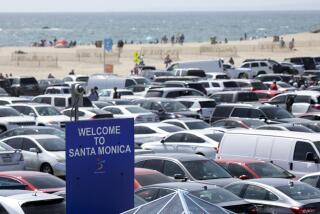$10 for parks?
- Share via
Californians love the state’s parks. We visit by the tens of millions every year. We vote for bonds to expand and enhance them. Then we let them fall apart.
Maintenance is always the overlooked stepchild of the budget process, and California’s state parks are especially prone to neglect because their needs -- dilapidated historic buildings, aging sewage treatment plants -- are less visible and immediate than, say, a pothole. The park system has racked up a $1.2-billion maintenance backlog at the same time that entry fees have risen to as much as $10 a day. Now Gov. Arnold Schwarzenegger has suggested closing up to 48 parks and cutting lifeguard staff at some state beaches.
In such dark days, it is noteworthy that Assemblyman John Laird (D-Santa Cruz) has devised a novel plan for re-funding the parks. Novel, but in the larger budget scheme not in the state’s best interests. Laird proposes adding a $10 surcharge on noncommercial vehicle registration fees, the money to be used to increase staff and reduce the maintenance backlog. Here’s the creative part: In exchange, cars bearing California plates would be allowed into the parks for free.
Laird says this would bring in $242 million in new money each year for parks, while handing Californians a gift in return. Certainly, frequent visitors would get a bargain, and the free pass might encourage more park use. Still, Laird’s logic doesn’t hold up. If most Californians were visiting state parks, the entry fees alone would generate that kind of money -- but the state now takes in only about $40 million a year. That means millions of Californians would be forced to pay for a gift they don’t want. To this, Laird responds that the parks are a public good to which everyone should contribute. He can’t have it both ways.
As a tax, the license surcharge would be regressive, costing motorists the same amount whether they drive a 20-year-old heap or a brand-new Porsche. And it would derail debate over increasing vehicle registration fees to close the shortfall in the state’s general fund.
Laird’s passion for making one great thing happen is commendable. But if the state ultimately relies on taxes to solve its budget shortfall, they should be the result of big-picture thinking that considers all of the state’s programs, each one a public good. Parceling out special taxes for projects here or there has rarely closed the gap between the state’s ambitions and its wallet. It won’t this time either.
More to Read
Sign up for Essential California
The most important California stories and recommendations in your inbox every morning.
You may occasionally receive promotional content from the Los Angeles Times.










